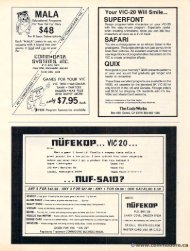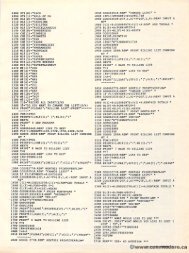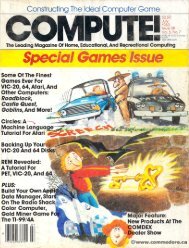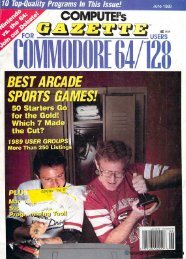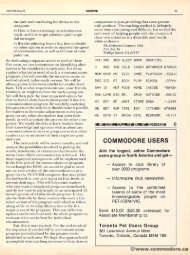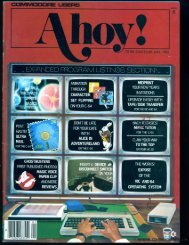May June 1980 - Commodore Computers
May June 1980 - Commodore Computers
May June 1980 - Commodore Computers
Create successful ePaper yourself
Turn your PDF publications into a flip-book with our unique Google optimized e-Paper software.
48 COMPUTE. MAY/JUNE. 198O <strong>1980</strong> ISSUE 4a<br />
Using The PET's Second CasseHe<br />
Using The PET's Second Cassette<br />
Buffer To Increase Available<br />
Memory Space<br />
Chuck Stuart, President<br />
CMS Software Systems, Inc.<br />
5115 Menefee Drive, Dallas, TX 75227<br />
If you have tried all the known memory savingg<br />
tricks to reduce the size of your new super program to<br />
save mankind and it still won't t fit into your PET's<br />
available able memory, you might be able to save the day<br />
by storing part pan of the program in the PET's second<br />
cassette buffer.<br />
The second cassette buffer begins at address 826<br />
and extends through address 1023. If your program<br />
does not use the second casselte cassette then you call can use<br />
thiss 197 bytes for r program storage. Granted, 197<br />
bytes may not see m like a lot of extra space, but<br />
bytes may not seem like a lot of extra space, but<br />
used correctlyy it can save you several limes times that<br />
much space in the PET's regular memory.<br />
.<br />
Suppose, forr instance, your program requires res a<br />
deck of 52 cards to be stored in memory. . Such a deck<br />
wou ld normally contain the va lues 1 through 52 a nd<br />
would normally contain the values 1 through 52 and<br />
be stored in an integer array referenced by a name<br />
like D % . Si nce each clement in an integer array re<br />
like D%. Since each element in an integer array re<br />
quires two bytes of memory and there are 52 elements<br />
in QU ourI' array, we can sec see that, al, s[O stored rc ci as a normal<br />
integer r array, our cleck deck of cards would require 104<br />
bytes of storage space plus atl least another 7 bytes<br />
and probably more to properly di mension the array.<br />
and probably more to properly dimension the array.<br />
Since no array clement element value exceeds 255, this<br />
array could easily be stored in the second cassette<br />
buffer with each element requiring only one byte fo r<br />
buffer with each element requiring only one byte for<br />
slOrage storage. . By moving g our deck of cards inlO into the<br />
second cassette buffer we have saved a minimum<br />
of 111 bytes of main memory while e using only 52<br />
bytes of the 197 available able to us in the second cassette<br />
buffer. T hi s same method works equally well for single<br />
buffer. This same method works equally well for single<br />
clement integer variables and strings.<br />
If you simply usc use this extra space for temporary<br />
storage of information during program operation then<br />
no special problems are crea ted. If yo u make full<br />
no special problems are created. If you make full<br />
usc use off the second cassette buffer for permanent<br />
storage of program data such as operator prompts,<br />
suit symbols for your card deck, orr other values<br />
normally stored in DATA Slalements, statements, etc., then the<br />
second cassette bu ffer must be stored along with the<br />
second cassette buffer must be stored along with the<br />
main program. Since the SAVE command begins<br />
s<br />
savingg att locationn 1024, any data stored below that<br />
address in the second cassette buffer would not be<br />
saved by using the standard SAVE command.<br />
Fortunately by us ing the PET's built-in ROM<br />
Fortunately by using the PET's built-in ROM<br />
Monitor o r wee can specify the exact beginning and ending<br />
addresses we want to save. If you still have the<br />
old ROM set without a Monitor don'tt panic. I I'll ' show you how to save the buffe r a li ttle later.<br />
show you how to save the buffer a little later.<br />
The first thing you have to do is determine thee<br />
address range you want to save in hexidedmal. idecimal. As<br />
we pointed Out out bcfore, before, the second cassette buffer<br />
begins al location 826 decimal or 033A in hex so we<br />
begins at location 826 decimal or 033A in hex so we<br />
know that we want to start saving at location<br />
033 A hex . To determine the ending address yo u must<br />
033A hex. To determine the ending address you must<br />
first save your program onto tape using g the normal<br />
SAVE command, and then load it back into memory<br />
with the LOAD command. . Data stored in the second<br />
cassette buffer will not be affected by this operation.<br />
Now type PRI NT PE EK( 43)'256 + PEEK(42). The<br />
Now type PRINT PEEK(43)*256 + PEEK(42). The<br />
answer you get willw be thc the address in decimal where<br />
your program ends and which you must now convert<br />
to hex. (If you've never taken the e time to LO learn how<br />
to 1O convert decimal to hex and vice versa because<br />
you figured you wouldd never need to know then you<br />
were wrong.)<br />
Now that you know the memory range you want<br />
to save, enter the Monitor by typing SYS1024 aand<br />
pressin g RETURN. To save your program including<br />
pressing RETURN. To save your program including<br />
the data slO stored in the second cassette buffer, type<br />
the following g line exactly, substitutingg the eending<br />
address for XXXX and filling ing in your own program<br />
name, and press RETURN:<br />
S ""PROGRAM NAME",01,033A,XXXX<br />
NAME",OI ,033A,XXXX<br />
PET will di splay the slandard PRESS PLA Y AND<br />
PET will display the standard PRESS PLAY AND<br />
RECORD message aand then save your program onn<br />
tape in the normal manner except it will begin<br />
saving at location n 826 instead of the usual<br />
location 1024 where you r BASIC program begin s.<br />
location 1024 where your BASIC program begins.<br />
You can LOAD aand use usc thee program ra m in the normal<br />
manner except that you must always use the Monitor<br />
to save the program or else you will lose any data<br />
slOred stored in the second cassette buffer. This means that<br />
no one else will be able to copy you r program un less<br />
no one else will be able to copy your program unless<br />
they know the secret. There is one other thing to<br />
remember. If you make any changes to your program ,<br />
remember. If you make any changes to your program,<br />
don't forget 1O to redetermine the new ending address<br />
before using the Monitor to resave the e program.<br />
If you have the old ROM set wilhoul a Monitor<br />
If you have the old ROM set without a Monitor<br />
then you can accomplish the same result resuh in the<br />
followingg manner:<br />
A) Save the program with the SAVE command<br />
and then reload it with the LOAD command.<br />
B) Type POKE247,58:POKE248,3 POKE248,3 and press<br />
RETURN.<br />
C) Type SYS63153 and press RETURN.<br />
PET will display the standard PRESS PLAY AND<br />
RECORD message and save the progra m beginn in g<br />
RECORD message and save the program beginning



